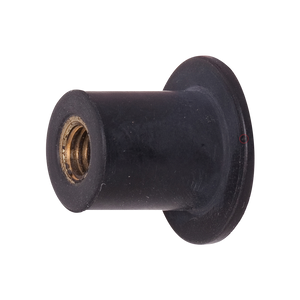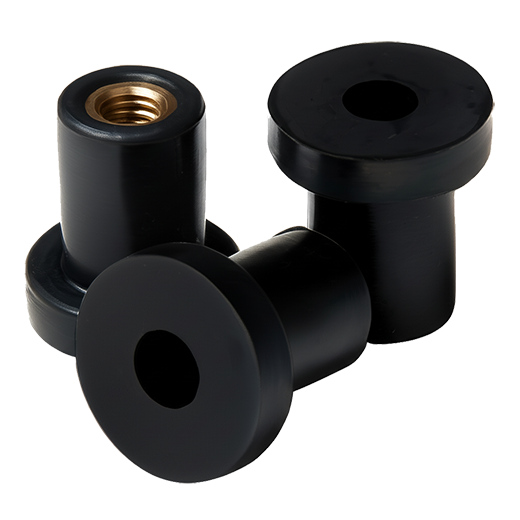Well Nut (rubber body with internal brass nut)
Brands you know and trust - Aerobolt®
Well Nuts. The Rubber Body Rivet Nuts.
Well nuts are a rubber body nut that consists of a neoprene bushing with an enlarged flange head on one end and a captive brass nut embedded on the inside at the other end. An excellent sealing option against air, moisture, and vibration. This makes well nuts ideal for lightweight bearing applications associated with fibreglass, plastics, glass or composite sheets. Refer to the tab below for an installation guide. Check out the nutsert blog.
Well Nuts - ideal when seeking a seal against air, moisture and vibration.
Well nuts are a rubber body threaded inserts / rivet nut.
Well nuts are a rubber body insert that consists of a neoprene bushing with an enlarged flange head on one end and a captive brass nut embedded on the inside at the other end. An excellent seal option against air, moisture, and vibration, which makes it ideal in lightweight bearing applications associated with fibreglass, plastics, or composite sheeting. Also referred to as a rawl nut, rawlnut, or a rubber nuts Check out the nutsert blog.
Well nuts are a bushing made from neoprene rubber. Well nuts are widely used in various industries, including automotive, heavy machinery, and construction, to reduce vibration, absorb shock, and isolate noise.
What it is:
- Neoprene bushings are essentially rubber sleeves or washers that are inserted between two connecting parts.
- They are designed to allow controlled movement between the parts while minimising noise, vibration, and wear.
- Neoprene rubber is a synthetic rubber known for its resistance to heat, oils, and chemicals, making it durable and long-lasting.
How it's used:
-
Vibration Isolation:
Neoprene bushings are commonly used in automotive suspensions, machinery, and other applications to absorb and dampen vibrations.
-
Shock Absorption:
They can help absorb shocks and impacts, protecting equipment from damage and ensuring smooth operation.
-
Noise Reduction:
By reducing vibration, neoprene bushings also help to minimize noise and create a quieter environment.
-
Other Applications:
Neoprene bushings can also be used in plumbing, as washers to create tight seals, due to their flexibility and corrosion resistance.
Advantages of Neoprene well nut bushings:
-
Durability:
Neoprene rubber well nuts are known for its resistance to wear, tear, and deterioration, making it a reliable choice for bushings.
-
Chemical Resistance:
It's resistant to various chemicals, oils, and solvents, making it suitable for a wide range of applications.
-
Weather Resistance:
Neoprene is also resistant to weathering, UV light, and ozone, ensuring it can withstand harsh environmental conditions.
-
Flexibility:
Neoprene bushings offer a good balance of flexibility and strength, allowing them to adapt to various movements and loads.
In Summary: Well nuts are versatile components that play a crucial role in vibration isolation, shock absorption, and noise reduction across various industries, thanks to the durability and resilience of neoprene rubber.
Great when seeking a seal against air, moisture and vibration.
Well Nut Lab - How To Install These Rubber Rivet Nuts.
Easy to install, no special tools required, just follow these simple steps:
- A hole must be drilled into the installation material. The hole will need to be the diameter of the rubber portion of the insert.
- Slide the insert into the hole so that the flange is the only portion of the nut exposed. At this point, a hole must be drilled into the material you wish to attach if it has not been drilled already.
- Place a washer onto the machine screw. You want to use a washer to press down on the flange portion of the well nut. Otherwise, the well nut will try to spin during installation.
- Line up the two holes and insert a machine screw that matches the threading of the well nut.
- Begin driving the machine screw (and washer) into the threads. As the well nut tightens, the rubber portion will start to deform and pull against the back of the installation surface creating a tight strong hold.
- Congratulate yourself. Job well done! :)
Well nuts are a rubber body threaded inserts / rivet nut.
Well nuts are a rubber body insert that consists of a neoprene bushing with an enlarged flange head on one end and a captive brass nut embedded on the inside at the other end. An excellent seal option against air, moisture, and vibration, which makes it ideal in lightweight bearing applications associated with fibreglass, plastics, or composite sheeting. Also referred to as a rawl nut, rawlnut, or a rubber nuts Check out the nutsert blog.
Well nuts are a bushing made from neoprene rubber. Well nuts are widely used in various industries, including automotive, heavy machinery, and construction, to reduce vibration, absorb shock, and isolate noise.
What it is:
- Neoprene bushings are essentially rubber sleeves or washers that are inserted between two connecting parts.
- They are designed to allow controlled movement between the parts while minimising noise, vibration, and wear.
- Neoprene rubber is a synthetic rubber known for its resistance to heat, oils, and chemicals, making it durable and long-lasting.
How it's used:
-
Vibration Isolation:
Neoprene bushings are commonly used in automotive suspensions, machinery, and other applications to absorb and dampen vibrations.
-
Shock Absorption:
They can help absorb shocks and impacts, protecting equipment from damage and ensuring smooth operation.
-
Noise Reduction:
By reducing vibration, neoprene bushings also help to minimize noise and create a quieter environment.
-
Other Applications:
Neoprene bushings can also be used in plumbing, as washers to create tight seals, due to their flexibility and corrosion resistance.
Advantages of Neoprene well nut bushings:
-
Durability:
Neoprene rubber well nuts are known for its resistance to wear, tear, and deterioration, making it a reliable choice for bushings.
-
Chemical Resistance:
It's resistant to various chemicals, oils, and solvents, making it suitable for a wide range of applications.
-
Weather Resistance:
Neoprene is also resistant to weathering, UV light, and ozone, ensuring it can withstand harsh environmental conditions.
-
Flexibility:
Neoprene bushings offer a good balance of flexibility and strength, allowing them to adapt to various movements and loads.
In Summary: Well nuts are versatile components that play a crucial role in vibration isolation, shock absorption, and noise reduction across various industries, thanks to the durability and resilience of neoprene rubber.
Great when seeking a seal against air, moisture and vibration.
Well Nut Lab - How To Install These Rubber Rivet Nuts.
Easy to install, no special tools required, just follow these simple steps:
- A hole must be drilled into the installation material. The hole will need to be the diameter of the rubber portion of the insert.
- Slide the insert into the hole so that the flange is the only portion of the nut exposed. At this point, a hole must be drilled into the material you wish to attach if it has not been drilled already.
- Place a washer onto the machine screw. You want to use a washer to press down on the flange portion of the well nut. Otherwise, the well nut will try to spin during installation.
- Line up the two holes and insert a machine screw that matches the threading of the well nut.
- Begin driving the machine screw (and washer) into the threads. As the well nut tightens, the rubber portion will start to deform and pull against the back of the installation surface creating a tight strong hold.
- Congratulate yourself. Job well done! :)








